Welcome to Catnapin's
Pink and Red Wildflower Gallery
Bilateral Symmetry - Orchid Family
_small.jpg)
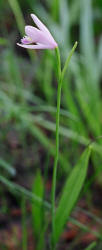
_small.jpg)
Orchidaceae - Orchid family
Rose Pogonia (Snake-mouth) Pogonia ophioglossoides
Flower is about 1" wide with crimson-purple veins and yellow projections.
There is one leaf halfway up the stem and a leaf-like bract under the
flower. Pogonia means bearded in reference to the lip. Ophioglossoides
refers to the orchids' resemblance to adder's tongue fern in having the
one leaf on the stem. The plant grows to about 16" tall. Grows in
acidic wetlands in pine savannahs. Blooms April-July.
Photos taken by Sonnia Hill in
Tyler County, Texas, April 2003
Close-up photo taken by Sonnia Hill in
Anderson County, Texas, May 2004
(Native of east Texas)
_small.jpg)
_small.jpg)
_small.jpg)
_small.jpg)
_small.jpg)
Orchidaceae - Orchid family
Grass-pink Calopogon tuberosus
Flower is about 1 1/2" wide. They bloom one at a time up the stem. For an
insect landing spot most orchids have a lip located at the bottom
(pedicel is twisted 180°). Oddly, this orchid has its lip at the top.
This genus offers no reward to pollinators, but its shape and bold
color mimic those that do. Pollinated by bumblebees and leafcutter
bees. One grass-like leaf at base. Calopogon means beautiful beard.
Plant usually grows to about 31" tall but can reach 53" tall. Grows in
acidic sand of wetland pine savannah. Blooms May-July.
Photos taken by Sonnia Hill in
Tyler County, Texas, May 2004, May 2005
(Native of east Texas)
_small.jpg)
_small.jpg)
_small.jpg)
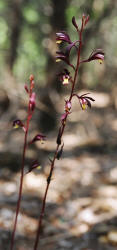
Orchidaceae - Orchid family
Texas Purple Spike Hexalectris warnockii
Maroon flower is about 1" wide and 3/4" long. Lip has two lateral lobes
(hood-like) and a middle lobe with five bright yellow-orange waxy
crests and a maroon tip. A rare variation is green (see below) instead
of maroon. No leaves. This plant does not produce chlorophyll. It is myco-heterotrophic, acquiring its nutrients through a symbiotic relationship with a mycorrhizal fungus. Plant grows to about 16" tall under open canopy of oak-juniper trees.
Photos taken by Sonnia Hill in Dallas County, Texas, July 2005

_small.jpg)
_small.jpg)
_small.jpg)
Orchidaceae - Orchid family
Arizona Crested Coral Root Hexalectris spicata var. arizonica
Tiny
flowers are under 1/2" long, often do not open, and are self
pollinating. Leafless stems are reddish or purple. Plant grows to about
31" tall. This plant does not produce chlorophyll. It is myco-heterotrophic, acquiring its nutrients through a symbiotic relationship with a mycorrhizal fungus. These plants like oak-juniper forests over limestone, often on a slight slope, with open canopy. Blooms May-August.
Photos taken by Sonnia Hill in
Dallas County, Texas, July 2005
(Native of Texas, east, central, far west - Brown, Coke)
_small.jpg)
_small.jpg)
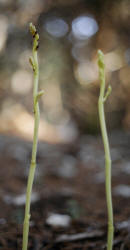
Orchidaceae - Orchid family
Shining Hexalectris Hexalectris nitida
Flowers are about 1/2" long, often do not open, and are self pollinating. A
variation is green instead of maroon. No leaves. This plant does not
produce chlorophyll. It is myco-heterotrophic, acquiring its nutrients through a symbiotic relationship with a mycorrhizal fungus. Plant grows to about 17" tall under open canopy of oak-juniper trees. Blooms June-August.
Photos taken by Sonnia Hill in
Dallas County, Texas, July 2005
(Native of Texas, rare in central and far west - Taylor)
_small.jpg)
_small.jpg)
_small.jpg)
_small.jpg)
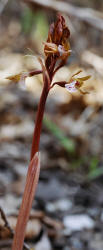
Orchidaceae - Orchid family
Spring Coralroot Corallorhiza wisteriana (Corallorrhiza wisteriana)
Flower is about 1/2" long, white with red-purple spots. They grow on a
spike-like raceme to about 16" tall from a pink rhizome. No
leaves. It is myco-heterotrophic, acquiring its nutrients through a symbiotic relationship with a mycorrhizal
fungus. The rhizomes are pink and branched like coral. It grows on leaf
mulch on limestone hills and in sand. Blooms February-March.
Photos taken by Sonnia Hill in
Dallas County, Texas, March 2005
(Native of Texas, east and central - Tom Green)
_small.jpg)
_small.jpg)
_small.jpg)
_small.jpg)
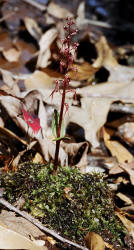
Orchidaceae - Orchid family
Southern Twayblade Listera australis
Tiny flower can be reddish-purple or green. The lip is deeply cleft in two
and is about 1/2" long. The other petals are tiny. Two opposite leaves
halfway up reddish-green stem. When an insect lands on the flower, it
touches trigger hairs that releases a squirt of glue then pollinia
(capsules of pollen). The stigma is covered to prevent
self-pollination. Plant grows to about 6" tall in clumps of moss
and humus within moist pine-hardwood forests. Blooms February-March.
Photos taken by Sonnia Hill in
Smith County, Texas, March 2004, March 2005
(Native of far east Texas)
|
Also see: yellow orchids white orchids |